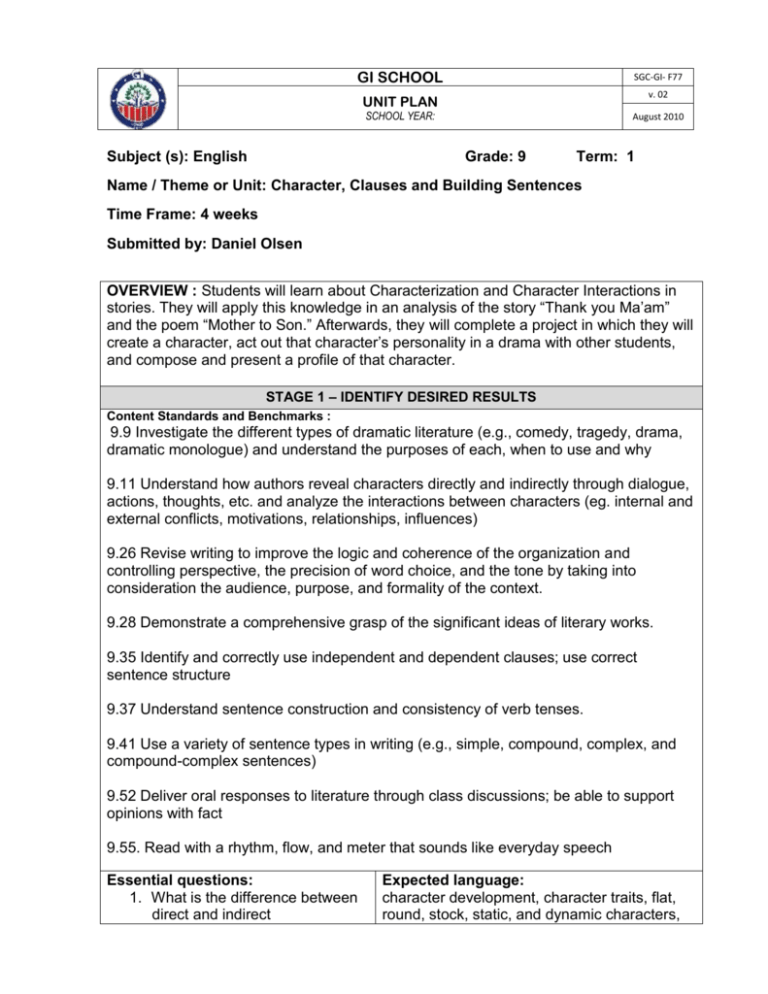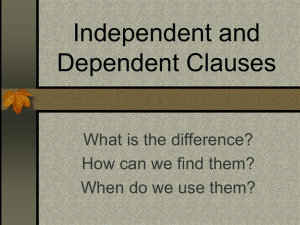English 9 1st Quarter - Unit 2 - Character - Olsen
advertisement

GI SCHOOL SGC-GI- F77 UNIT PLAN v. 02 SCHOOL YEAR: Subject (s): English August 2010 Grade: 9 Term: 1 Name / Theme or Unit: Character, Clauses and Building Sentences Time Frame: 4 weeks Submitted by: Daniel Olsen OVERVIEW : Students will learn about Characterization and Character Interactions in stories. They will apply this knowledge in an analysis of the story “Thank you Ma’am” and the poem “Mother to Son.” Afterwards, they will complete a project in which they will create a character, act out that character’s personality in a drama with other students, and compose and present a profile of that character. STAGE 1 – IDENTIFY DESIRED RESULTS Content Standards and Benchmarks : 9.9 Investigate the different types of dramatic literature (e.g., comedy, tragedy, drama, dramatic monologue) and understand the purposes of each, when to use and why 9.11 Understand how authors reveal characters directly and indirectly through dialogue, actions, thoughts, etc. and analyze the interactions between characters (eg. internal and external conflicts, motivations, relationships, influences) 9.26 Revise writing to improve the logic and coherence of the organization and controlling perspective, the precision of word choice, and the tone by taking into consideration the audience, purpose, and formality of the context. 9.28 Demonstrate a comprehensive grasp of the significant ideas of literary works. 9.35 Identify and correctly use independent and dependent clauses; use correct sentence structure 9.37 Understand sentence construction and consistency of verb tenses. 9.41 Use a variety of sentence types in writing (e.g., simple, compound, complex, and compound-complex sentences) 9.52 Deliver oral responses to literature through class discussions; be able to support opinions with fact 9.55. Read with a rhythm, flow, and meter that sounds like everyday speech Essential questions: 1. What is the difference between direct and indirect Expected language: character development, character traits, flat, round, stock, static, and dynamic characters, characterization? 2. What are the ways in which characters are revealed indirectly? 3. How can a character’s personality be revealed through dramatic presentation? 4. What motivates characters, and how does this make them more like real people? 5. What are the roles that characters play when interacting with each other in stories 6. What are clauses, and how are they constructed? 7. What are the rules for constructing sentences out of clauses correctly? indirect and direct characterization, actions, narrator, dialogue, description, profile, script, dramatic presentation, subject, predicate, independent clause, subordinate clause, complex sentence, compound sentence, simple sentence, run-on sentence, fragment. STAGE 2 – ASSESSMENT EVIDENCE List performance tasks or project, quizzes, graded assignments, prompts, etc. Include the rubrics you use to evaluate the performance tasks. Grammar – Clauses and Building Sentences Clause Practice Warm up Worksheets Building Sentences Practice Warm up Worksheets Sentence Practice Assignment Gr. 9 Review games Test on Clauses and Building Sentences Character and “Thank you Maam” Characterization Drama Activity Character Profile Writing Assignment Character Profile Presentation Assignment Quiz on character notes Thank you Ma’am character chart and Test Practice Questions STAGE 3 – LEARNING ACTIVITIES Consider the type of knowledge (declarative or procedural) and the thinking skills students will use. Grammar – Clauses and Building Sentences Students will begin the unit with a brief review of the parts of the Sentence and begin work on clauses with the introduction notes and conjunction list handout . Throughout the Unit, the students will complete the Clauses and Building Sentences worksheets projected on the board at the beginning of every class for 5-10 minutes with help from the teacher and other students. Students may download and print the worksheets ahead of time from the wiki, or they may copy them out in class from the board. At the end of each session, the teacher will give the answers. At the end of each week, the accumulated worksheets will be collected for a mark. To assess progress nearer to the end of the unit, the students will spend a class practicing complex sentences with the Sentence Practice Assignment . At the end of the unit, students will play two different review games on two different days, a sentence construction game using a list of clauses and conjunctions , and a Sentence Structure Jeopardy game . Finally, they will write a test on Clauses and Building Sentences Character and analysis of “Thank you Ma’am” Students will view and take notes on a power point on Characterization . Afterwards, students will review their notes and fill in the chart from the power point using a famous character. Afterwards they will discuss and compare with other students. Students will view a series of pictures of Harlem and quietly write, then discuss their predictions of what the story “Thank you Ma’am” (in the textbook) will be about. Then they will view the introduction power point on the story and preview the vocabulary . When reading the story, the students will revisit their notes and discuss how the characters are revealed in the story, focusing particularly on dialogue. Students will listen to a recording of the story and then re-read various parts involving dialogue, assigning roles to individual students. Students will each get a chance to speak, and they will receive feedback for their fluency and character portrayal. After the story, students will complete the Character Chart and Practice Questions . As further oral practice in rhythm and fluency, Students will read the poem “Mother to Son” (in textbook, immediately following the story). Students will then take notes on a second power point on character interactions . With the use of their notes, students will complete a quiz on both characterization and character interactions . Character Creation Project Next, students will do multi-part character creation project in which they will create, write about, and deliver presentations on a character. Using the Character Drama Activity , the students will be given a name for a character and be required to invent a personality, with habits, character traits, etc. In an assigned group, they will be given a situation, and write and perform a brief drama in which the characters all interact in a way consistent with their created personalities. Afterwards, the students will write a descriptive profile of their characters in which they will be required to describe their character’s motivations, role in the mini drama, and how their personality was revealed. The will hand in all their collected notes and drafts to demonstrate the writing process, and be marked on the six traits scale. Students will be expected to apply their knowledge of sentence structure to the writing assignment for their conventions mark. Finally, the students will draw a picture as a visual aid and present their character profiles orally to the class for a presentation mark. INSTRUCTIONAL MATERIALS AND RESOURCES Holt Supplementary power points Holt Language and Literature Text: “Thank you Ma’am,” “Mother to Son.” Grammar worksheets Teacher Created Resources At the end of unit: CURRICULUM COVERAGE: Percentage of planned curriculum that was taught and assessed __%90____ REFLECTIONS: Teachers reflections on ways in which the unit might be improved, polished or enhanced. Student perspectives might be included. The unit went well. I decided to delay the unit on building sentences until next quarter as it was sufficiently challenging for the students to practice identifying clauses and interpreting sentences. The students responded very well to all the stories read and engaged with the material. I chose to spend more time on vocabulary acquisition assessed this separately from the tests on individual units. This allowed students to use dictionaries in regular tests.









